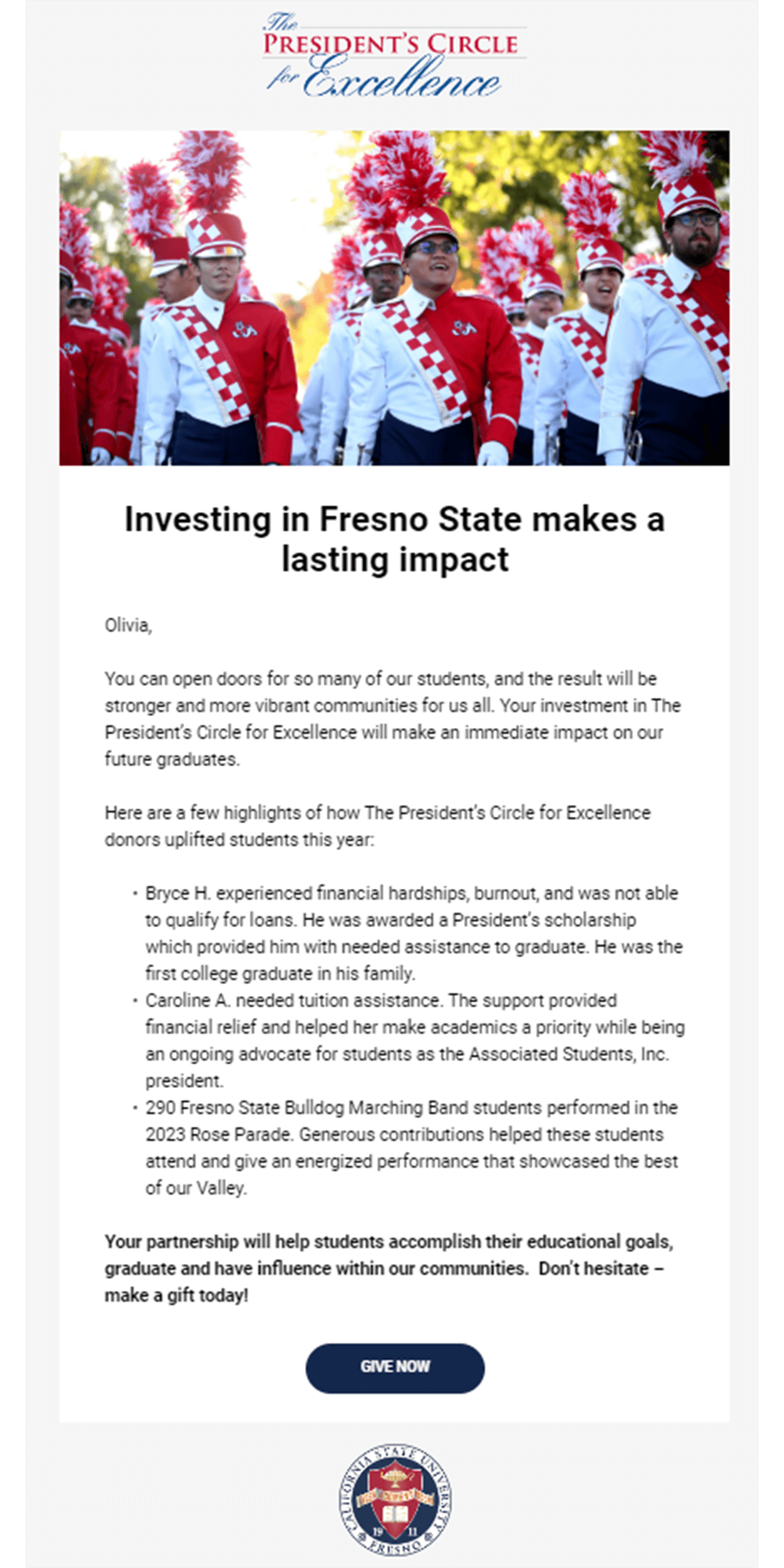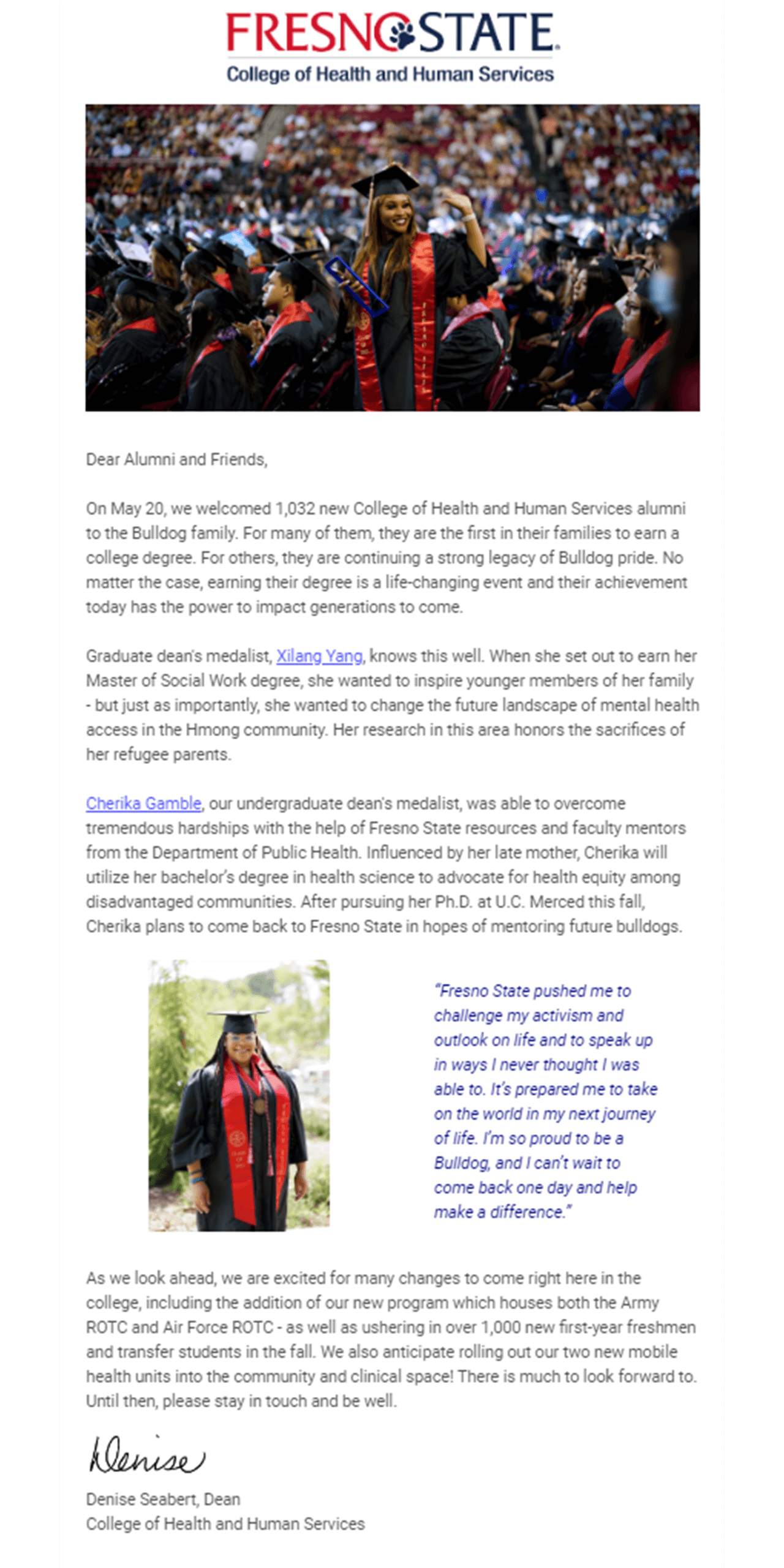University Marketing and Communications
Emails: The most effective marketing channel out there.
Email is a key platform to engage with your audiences, share news and information, drive attendance to events and solicit donations. Every email message should be strategic, concise, blend visuals and copy in an impactful but accessible way, and offer recipients a clear call to action.
Email marketing to Fresno State’s external audience (alumni, donors and the general community) is managed by University Marketing and Communications.
We use iModules Encompass to distribute all mass emails. We have mobile-friendly design templates and keep best practices in mind when sending emails.
When to utilize University Marketing and Communications
Submit an email marketing request to University Marketing and Communications at least two weeks in advance if you are:
- Sending a solicitation email (asking for donations)
- Emailing over 100 alumni, donors or community members
- Sending an official institutional mass email from your office or the university (not a personal email)
How it Works
It starts with strategy
Before you consider sending a mass email to alumni, donors or friends — ask yourself why.
Yes, email is a vital channel for fundraising, ticket sales, college news, alumni engagement — you name it — but all that email can sometimes lead to communications overlap and a lack of branding and quality control.
We also need to be conscious of the university’s opt-outs. Per the CAN-SPAM Act, recipients of a Fresno State mass email have a right to unsubscribe from future email messages. Over-emailing the same audience can lead to an increase in unsubscribes. Once people unsubscribe, we can’t email them again.
Want to send a mass email? Ask yourself these questions first:
- What’s the one key message you want to get across in the email? Why should recipients care?
- Does your message constitute its own email, or should it be included in an e-newsletter or on social media instead?
- What action do you want recipients to take? (What do you want recipients to do after they read your email? E.g. donate, register for an event, etc.)
- How will you measure success?
Read the best practices
Did you know that using the word “invitation” in your subject line leads to a 9.45% increase in open rates? Did you know there are better days to send emails than others? There are tips and tricks to increase the effectiveness of your emails. Read the best practices below.
Prepare your email
Here’s what you’ll need to prepare before submitting an email marketing request to University Marketing and Communications:
- Date (When would you like this email to be distributed?)
- Type of email (Donation solicitation, e-newsletter, event invite, informational/engagement?)
- Target Audience (Who is this email being sent to?)
- From Name (Department, college or person this email is coming from. Note: Emails with a familiar “from name” have higher open rates.)
- Reply-To Email Address (The owner of this email address is responsible for answering email responses and forwarding unsubscribe requests to the marketing team.)
- Subject Line (Approx. 35-50 characters)
- Pre-Header Text (Short summary text that follows the subject line; approx. 85 characters)
- Email Body (Important: Please be as clear, concise and compelling as possible. The information you provide is what will appear as the email body. The marketing team will help provide copy/edit services)
- Call to Action (e.g. Register now, Learn more, Donate today; Make sure to include link)
- Photo (Please provide an appropriate and high quality photo. The marketing team will help provide a photo if requested)
Submit a request for email marketing
Submit a request for email marketing by emailing the Digital Marketing Specialist. Make sure to include the information you prepared above in the request. We’ll follow up and send you a preview of the email before it’s distributed.
Remember that we need at least two weeks’ notice before the distribution date of your email. If it’s a solicitation email, we may need more time. If emails to the same audience are already scheduled for the distribution date you requested, we may need to reschedule your email.
Email Marketing Best Practices
Timing
In general, Tuesday, Wednesday, and Thursday are the best days of the week to distribute emails (leading to higher open rates). But we need to be mindful of other messages being sent out on those days. An overwhelming amount of content directed at the same target audiences results in a high degree of overlap and message saturation.
Because audience satisfaction is primary, prioritization of mass email requests will be based on the timeliness of the message and the emails already being directed to the target audience.
Segmenting your audience
Sometimes we want to cast the widest net possible and email everyone with our message. However, this has negative consequences not only on the email performance, but for the university. Research shows that the more narrow the audience and the more relevant the email campaign is, the better the email performs — leading to higher open rates, higher click-through rates, and lower opt-out rates.
When recipients opt out of Fresno State emails, no one can email them again. Additionally, if a recipient feels like an email is irrelevant to them, they may block the sender or mark the message as spam. This damages Fresno State’s sender reputation and leads to more emails from Fresno State being delivered straight into recipients’ spam boxes.
That’s why it’s important to segment your audience as much as possible. For example, if you would like to invite people to an on-campus event benefiting the Lyles College of Engineering, consider narrowing your target audience to:
- Local alumni (in Fresno, Tulare and Madera counties)
- Engineering graduates only
- Donors who have given to the Lyles College of Engineering in the past five years
Subject lines
There are three things to consider when crafting your email subject line:
- Accurate and reflective: Avoid using vague or misleading subject lines, which is a violation of the CAN-SPAM Act.
- Short: It’s advisable to keep subject lines under 35 characters long to ensure they appear in full on both desktop and mobile devices.
- Compelling: Use compelling words that reel your reader into the topic of the email. Here are some
words that research shows lead to higher open rates:
- Invitation
- Introducing
- You/Your
- Year and Month (e.g. May 2019, December 2020)
- Update
- New
If you need help developing a compelling subject line, check out CoSchedule’s free headline analyzer tool.
Email content
The body of your email should be personal, focused, clear and concise. Email marketing experts recommend using the inverted triangle method to drive engagement. Here’s how it works for Fresno State emails:


Visuals
Bold visuals are impactful and help break up copy, making emails easier to digest. However, not all email service providers will display your email images, so you should never rely on an image to convey the message of your email. Additionally, image-heavy emails are more likely to end up in recipients’ spam boxes.
Here are our rules for using visuals in mass emails:
Use impactful visuals: Your image should not be your entire message (e.g. a screenshot of a flyer — that’s not ideal for web accessibility). However, your visual should complement your message, using bold colors and conveying Fresno State’s key brand pillars. We recommend using photos taken by our university photographer.
Representation matters: We know not all diversity is visible, but it’s important to be as inclusive as possible in our photos of people while being representative of our campus demographics. Research shows that when minorities see themselves represented at an institution (through its marketing efforts and curriculum), they’re more likely to succeed. Read Fresno State’s definition of diversity here.
Always use alt text: Alt text is the html-coded text that appears when an image doesn’t load (it’s short for “alternative text“). It should be a brief description that conveys meaning and identifies the content in the image. Recipients who are visually-impaired may use screen readers to understand what the image is. That’s why alt text is always essential.
Compress, compress, compress: Large image files can create significant spam and email deliverability issues. Small, compressed, well-formatted images are the key to successful use of email images. Here’s a free online image compression tool.
Horizontal images are your friend: We recommend using images that are at least 600 px wide, and at most, 400 px high.
Calls to action
All emails should close with an abundantly clear call-to-action. Ask yourself: What do you want recipients to do after they read your email? Here are some examples:
- Donate to Fresno State now
- Register for the event today
- Read more about faculty
- RSVP now
- Visit the website
- Learn more about the program
- Take the survey
- Watch now
It’s a bad practice to say “click here,” since approximately 50% of recipients are reading your email on their mobile phone (meaning they’re actually “tapping” instead of clicking).
Preferably, the call-to-action link is the only URL used in the email. We don’t want recipients to end up in other windows, away from your email, unless they’re taking your desired action. We can run analytics reports to see how many users clicked on your call-to-action. This is one way to measure an email’s success.